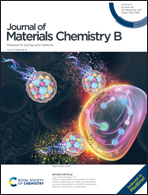The tumor phototherapeutic application of nanoparticles constructed by the relationship between PTT/PDT efficiency and 2,6- and 3,5-substituted BODIPY derivatives†
Abstract
BODIPY dyes have recently been used for photothermal and photodynamic therapy of tumors. However, complex multi-material systems, multiple excitation wavelengths and the unclear relationship between BODIPY structures and their PTT/PDT efficiency are still major issues. In our study, nine novel BODIPY near-infrared dyes were designed and successfully synthesized and then, the relationships between BODIPY structures and their PTT/PDT efficiency were investigated in detail. The results showed that modifications at position 3,5 of the BODIPY core with conjugated structures have better effects on photothermal and photodynamic efficiency than the modifications at position 2,6 with halogen atoms. Density functional theory (DFT) calculations showed that this is mainly due to the extension of the conjugated chain and the photoinduced electron transfer (PET) effect. By encapsulating BDPX-M with amphiphilic DSPE-PEG2000-RGD and lecithin, the obtained NPs not only show good water solubility and biological stability, but also could act as superior agents for photothermal and photodynamic synergistic therapy of tumors. Finally, we obtained BODIPY NPs that exhibited excellent photothermal and photodynamic effects at the same time under single irradiation with an 808 nm laser (photothermal conversion efficiency: 42.76%, A/A0: ∼0.05). In conclusion, this work provides a direction to design and construct phototherapeutic nanoparticles based on BODIPY dyes for tumor treatment.



 Please wait while we load your content...
Please wait while we load your content...